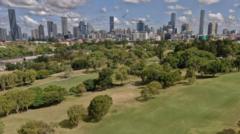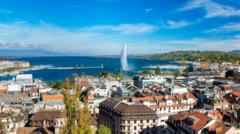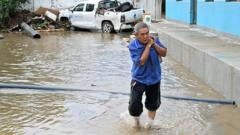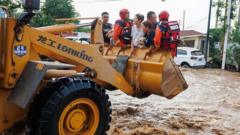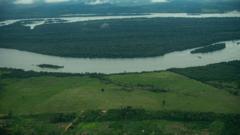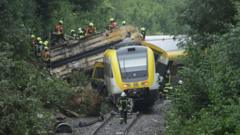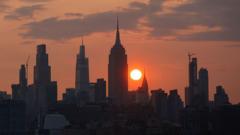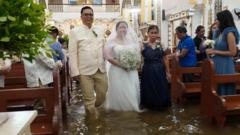As glaciers recede and landslide risks increase, Swiss villagers grapple with the financial and emotional costs of rebuilding after disasters.
Swiss Villages at Risk: The Melting Glaciers Dilemma
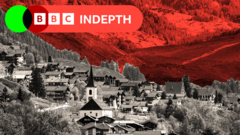
Swiss Villages at Risk: The Melting Glaciers Dilemma
Climate change threatens the cultural heritage and future of alpine communities in Switzerland.
In the picturesque Loetschental valley of Switzerland, the toll of climate change is strikingly evident. Recent disasters have left the small village of Blatten in ruins, a stark reminder of nature’s volatility exacerbated by warming temperatures. Matthias Bellwald, a local mayor, oversees recovery efforts following the catastrophic collapse of a glacier that obliterated the village, displacing approximately 300 residents.
As people try to settle into temporary accommodations across nearby Wiler, concerns mount not only over the cost of rebuilding Blatten—estimated at an astounding $1 million per resident—but also over whether preserving such communities is viable or wise in an era of increasing natural threats. The excitement of returning home is mixed with uncertainty, as the same climate forces that destroyed their lives are projected to bring further instability, including landslides, to the Alps.
Many locals cling to a resilient sense of identity tied to their heritage. For generations, the village’s charm—filled with traditions, unique dialects, and cultural practices—has been a stronghold of community spirit. However, as the glaciers shrink, and with them the stability of the mountains, residents must address whether salvaging their histories is worth the monumental financial investment.
Recent statistics show that Switzerland spends nearly $500 million annually to fortify areas against natural hazards, but experts claim much larger sums may be needed as climate impacts grow. The situation raises emotional questions too. For individuals like Lukas Kalbermatten, who lost a family-run hotel of three generations, the pain of displacement is both financial and deeply personal.
Seeking refuge in discussions about the potential disappearance of alpine culture, locals remain divided over the implications of abandoning certain villages. Rich traditions, such as the culturally significant Tschäggättä masks, are seen as symbols of a vanishing way of life. Memories of past joys interwoven with the vibrant tapestry of alpine existence hang in the balance, prompting some to argue that relocation may be necessary.
As communities purposefully navigate the outcome of monumental loss, glaciologists warn of accelerating climate impacts that are already amplifying geological risks. Blatten’s predicament raises a crucial self-assessment for all mountainous Switzerland: How many villages can afford to be saved, and at what long-term cost, when preservation may clash head-on with nature’s ruthlessness?
In a country defined by its mountains, the ongoing struggle embodies not just the fight for survival, but the urgency to comprehend and adapt to the evolving landscape threatening generations of heritage—an existential conversation echoed in the heart of every village, where memories and futures coalesce amid shifting terrains.
As people try to settle into temporary accommodations across nearby Wiler, concerns mount not only over the cost of rebuilding Blatten—estimated at an astounding $1 million per resident—but also over whether preserving such communities is viable or wise in an era of increasing natural threats. The excitement of returning home is mixed with uncertainty, as the same climate forces that destroyed their lives are projected to bring further instability, including landslides, to the Alps.
Many locals cling to a resilient sense of identity tied to their heritage. For generations, the village’s charm—filled with traditions, unique dialects, and cultural practices—has been a stronghold of community spirit. However, as the glaciers shrink, and with them the stability of the mountains, residents must address whether salvaging their histories is worth the monumental financial investment.
Recent statistics show that Switzerland spends nearly $500 million annually to fortify areas against natural hazards, but experts claim much larger sums may be needed as climate impacts grow. The situation raises emotional questions too. For individuals like Lukas Kalbermatten, who lost a family-run hotel of three generations, the pain of displacement is both financial and deeply personal.
Seeking refuge in discussions about the potential disappearance of alpine culture, locals remain divided over the implications of abandoning certain villages. Rich traditions, such as the culturally significant Tschäggättä masks, are seen as symbols of a vanishing way of life. Memories of past joys interwoven with the vibrant tapestry of alpine existence hang in the balance, prompting some to argue that relocation may be necessary.
As communities purposefully navigate the outcome of monumental loss, glaciologists warn of accelerating climate impacts that are already amplifying geological risks. Blatten’s predicament raises a crucial self-assessment for all mountainous Switzerland: How many villages can afford to be saved, and at what long-term cost, when preservation may clash head-on with nature’s ruthlessness?
In a country defined by its mountains, the ongoing struggle embodies not just the fight for survival, but the urgency to comprehend and adapt to the evolving landscape threatening generations of heritage—an existential conversation echoed in the heart of every village, where memories and futures coalesce amid shifting terrains.

